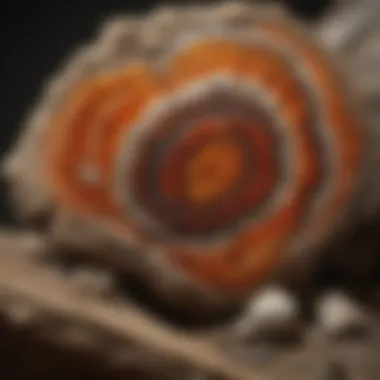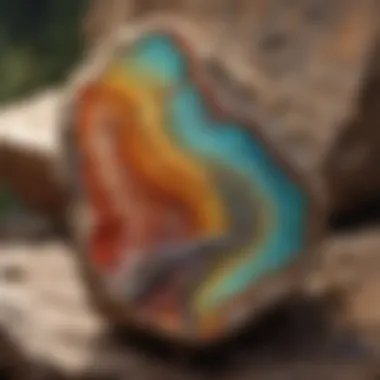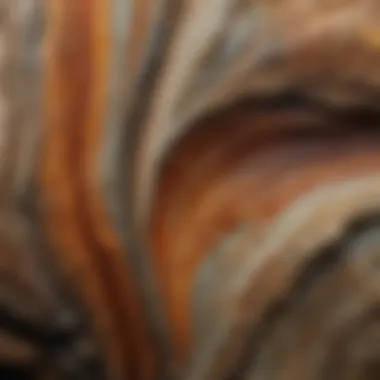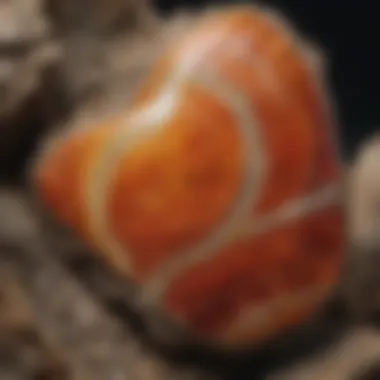Unveiling the Enigmatic Opalized Petrified Wood: A Geological Marvel


Rock and Fossil Identification
Opalized petrified wood is a captivating fusion of two ancient natural elements, opal, and wood, preserved over thousands of years. When identifying opalized petrified wood, it is essential to understand the key characteristics that distinguish it from other rocks and fossils. The unique feature of opalization in petrified wood gives it a colorful play-of-color and a smooth, polished texture. This distinctive attribute sets it apart from regular petrified wood and other opalized stones. Tools such as magnifying glasses and UV lights can be instrumental in identifying these remarkable specimens.
Geological Origins and Formation Processes
To truly appreciate opalized petrified wood, one must delve into its geological origins and formation processes. This exceptional gemstone is formed when the organic wood material is replaced with silica-rich solutions, ultimately creating a stunning opal matrix within the preserved wooden structure. It is a fascinating representation of nature's ability to transform and preserve ancient remnants over time. Understanding the intricate geological processes behind opalized petrified wood adds a deeper layer of appreciation for its rarity and beauty.
Significance in Paleontological Discoveries
Opalized petrified wood plays a significant role in paleontological discoveries, offering valuable insights into ancient ecosystems and environments. Fossilized wood specimens containing opal reveal important information about the flora that existed in prehistoric times and help researchers reconstruct past environments. These unique fossils provide a tangible link to the distant past, shedding light on the evolution of plant life and geological changes throughout history.
Preservation and Display Techniques
Preserving opalized petrified wood requires special care to maintain its color and luster over time. Proper storage methods involve keeping the specimens away from direct sunlight and extreme temperatures to prevent any damage to the delicate opal component. Creative display ideas can enhance the beauty of opalized petrified wood, from placing them in shadow boxes to designing custom stands that showcase their mesmerizing colors. By employing techniques that prioritize the preservation and aesthetic appeal of these specimens, collectors can enjoy their splendor for generations to come.
Introduction to Opalized Petrified Wood
Opalized petrified wood stands as a true marvel of nature, merging the ethereal beauty of opal with the ancient wisdom held within petrified wood, offering a captivating insight into geological history. This section serves as the bedrock for our exploration, setting the stage for a deep dive into the intriguing world where opulence meets antiquity. Understanding the nuances of opalized petrified wood allows enthusiasts and collectors alike to appreciate the profound fusion of elements that have endured millennia.
The Origins of Opalized Petrified Wood
Formation Process of Opalized Petrified Wood
The formation process of opalized petrified wood unveils a meticulous interplay between mineral infiltration and organic matter replacement. This unique process begins with the gradual permineralization of wood by silica-rich waters, paving the way for the opalization transformation to take place. The key characteristic lies in the preservation of wood's cellular structure while infusing it with opal hues, resulting in a stunning marriage of organic and inorganic elements. The advantage of this process lies in the exquisite patterns and colors that manifest, showcasing nature's artistic prowess in preserving ancient stories within opalescent layers.
Geological Factors Influencing Opalization
Geological factors play a pivotal role in the opalization of petrified wood, with specific conditions such as volcanic activity, sedimentary deposition, and groundwater composition shaping this phenomenon. These factors contribute to the unique opalization seen in various regions, with differing mineral compositions yielding a kaleidoscope of colors and textures. The geological influence creates a spectrum of opalization possibilities, echoing the diverse landscapes where these precious gems are unearthed.


Distinctive Features and Characteristics
Opalization Patterns and Colors
Opalization patterns and colors breathe life into petrified wood, showcasing a myriad of vibrant hues and intricate designs crafted by nature's hand. These patterns and colors reflect the environment in which opalization occurred, from fiery reds to serene blues, offering a visual feast for collectors and admirers. The uniqueness of each opalized piece lies in its unparalleled beauty, serving as a testament to the transformative power of time and elements.
Texture and Composition of Opalized Wood
The texture and composition of opalized wood unveil a tactile journey through epochs long past, with each grain and fiber immortalized in opal's translucent embrace. The interplay of wood fibers and opal layers creates a textural tapestry that invites exploration through touch, highlighting the smooth luster and organic warmth inherent to opalized petrified wood. This fusion of textures enriches the viewing experience, adding depth and dimension to the tangible connection with ancient arboreal wonders.
Significance and Value
Collectibility Among Enthusiasts
Opalized petrified wood holds a distinct allure for enthusiasts and collectors, captivating hearts with its rare beauty and historical significance. The collectibility of these gems transcends mere ownership, encapsulating a deep appreciation for Earth's transformative processes and the enduring legacy of ancient forests. Each piece represents a unique chapter in geological history, igniting a passion for preservation and exploration among fervent admirers.
Market Value and Rarity
The market value and rarity of opalized petrified wood underscore its esteemed status within the realm of precious stones and fossilized treasures. As a limited resource with finite supply, opalized wood commands attention for its scarcity and exceptional beauty. Its rarity enhances both its cultural and monetary worth, making it a coveted addition to any collector's repertoire. The enduring allure of opalized petrified wood lies not only in its market value but also in the ineffable value of owning a piece of Earth's ancient past.
Exploration of Opalized Petrified Wood Sites
In the vast landscape of geological wonders, the exploration of opalized petrified wood sites stands out as a compelling endeavor. This section of the article focuses on delving into the significance, elements, benefits, and considerations surrounding the exploration of these unique locations.
Opalized petrified wood sites serve as windows into the ancient past, offering a glimpse of the mesmerizing fusion of opal and petrified wood that has endured through millennia. By visiting these sites, enthusiasts and researchers can witness firsthand the intricate beauty and geological importance of this rare gem.
Understanding the geological context of opalization and its manifestation in petrified wood requires on-site exploration at renowned locations worldwide. From Arizona's Petrified Forest National Park to opal mines in Australia, these sites provide valuable insights into the formation process and distinctive features of opalized petrified wood.
Explorers are drawn to these sites not only for their scientific significance but also for the awe-inspiring beauty they hold. The colors, patterns, and textures of opalized wood found in these locations tell a story of earth's ancient history, making each visit a journey through time and nature's artistry.
Renowned Locations for Opalized Petrified Wood


Arizona's Petrified Forest National Park
Arizona's Petrified Forest National Park stands as a testament to the petrification process that took place millions of years ago. The park is renowned for its vast deposits of petrified wood, transformed into vibrant shades of opalized perfection. Visitors to this geological wonderland witness the striking hues of reds, yellows, and greens preserved in the petrified logs, a sight that captivates the imagination.
One of the key characteristics of Arizona's Petrified Forest National Park is its accessibility to visitors keen on exploring the wonders of opalized petrified wood. The park offers guided tours, educational exhibits, and well-maintained trails that allow for a comprehensive experience of this geological marvel. The sheer expanse of petrified wood scattered across the park showcases the magnitude of earth's transformation over time, making it a beneficial choice for inclusion in this article.
Visitors can marvel at the unique feature of logs that have crystalized into opal, creating a kaleidoscope of colors that shimmer in the desert sun. Whether for educational purposes or sheer aesthetic pleasure, Arizona's Petrified Forest National Park offers a prime example of opalized petrified wood's beauty and geological importance.
Opal Mines in Australia
Opal mines in Australia present another fascinating destination for those intrigued by opalized petrified wood. These mines have been instrumental in unearthing rare specimens of opalized wood, showcasing the geological diversity and artistry of nature.
The key characteristic of opal mines in Australia lies in their abundance of opalized petrified wood, providing a wealth of specimens for researchers and collectors alike. The mines offer a gateway to understanding the opalization process and the conditions that have led to the preservation of wood in opal form, making them a popular choice for inclusion in this article.
Visitors to these mines can witness the unique feature of miners delicately extracting opalized wood from its rocky confines, using specialized tools and techniques. The advantages of these mines include the access they provide to rare opalized wood specimens, offering insights into the beauty and complexity of opal formation in a geological context.
Opalized Petrified Wood in Art and Design
Delving into the captivating world of opalized petrified wood unveils a realm where nature's artistry meets human creativity. The integration of opalized wood in artistic endeavors holds profound significance in its ability to bridge the ancient with the contemporary, infusing unique characteristics and ethereal beauty into diverse forms of art and design. This section will intricately explore the utilization of opalized petrified wood in jewelry, decor, and its role in inspiring artistic expressions.
Utilization in Jewelry and Decor
Opalized Wood in Handcrafted Jewelry
The adaptation of opalized wood in handcrafted jewelry epitomizes elegance and mystique. Each piece encapsulates a narrative of history and aesthetics, making it a cherished choice among artisans and collectors alike. The key allure of opalized wood in jewelry lies in its kaleidoscopic opalization patterns, which infuse a mesmerizing play of colors and textures, reminiscent of ancient landscapes frozen in time. This distinctive feature not only renders opalized wood jewelry a visually stunning adornment but also infuses each piece with a sense of rarity and individuality. While the unique nature of opalized wood jewelry provides a one-of-a-kind appeal, it also presents challenges in crafting and maintaining these exquisite pieces.
Decorative Applications in Interior Design
In the realm of interior design, opalized petrified wood stands as a versatile and captivating element for adding aesthetic flair to living spaces. Its utilization in decor exemplifies a harmonious fusion of nature's beauty and human innovation, catering to connoisseurs seeking to imbue their surroundings with unparalleled elegance. The distinctive characteristics of opalized wood, such as its iridescent hues and intricate patterns, make it a sought-after choice for interior designers looking to create unique focal points in residential and commercial spaces. Despite its undeniable beauty, incorporating opalized wood in design schemes requires a delicate balance to ensure its integration harmonizes with existing aesthetics while highlighting the inherent allure of this rare gem.


Artistic Interpretations and Inspirations
Exploring the artistic interpretations and inspirations drawn from opalized petrified wood unveils a world of boundless creativity and innovation. Artisans and designers are continuously inspired by the ethereal beauty of opalized wood, seeking to translate its mesmerizing qualities into stunning works of art that captivate and enchant audiences.
Artisan Creations Incorporating Opalized Wood
Within the realm of artisan creations, opalized wood serves as a muse for designers to push the boundaries of creativity and craftsmanship. The key characteristic of opalized wood as a medium for artistic expression lies in its ability to evoke a sense of wonder and connection to the natural world. Artisans harness the unique features of opalized wood to create bespoke pieces that showcase the intersection of artistry and natural beauty, culminating in creations that resonate with collectors and enthusiasts alike. While the incorporation of opalized wood in artisanal creations opens avenues for innovative designs, it also necessitates a nuanced approach to preservation and presentation to preserve its inherent allure.
Influence on Contemporary Art Trends
The influence of opalized petrified wood on contemporary art trends signifies a shift towards embracing the raw beauty and ancient origins inherent in this geological marvel. Artists across diverse mediums draw inspiration from the luminous hues and intricate textures of opalized wood, incorporating these elements into their works to evoke a sense of ethereal enchantment and timeless elegance. The unique feature of opalized wood's influence on contemporary art lies in its transformative power to infuse traditional artistic practices with a touch of the primordial, inviting viewers to reimagine familiar themes through the lens of ancient splendor. While the incorporation of opalized wood in contemporary art opens new avenues for artistic exploration, it also prompts a reevaluation of conventional artistic norms and interpretations, challenging creators and audiences to engage with the mesmerizing allure of this rare gem in fresh and innovative ways.
Preservation and Ethical Considerations
In the realm of opalized petrified wood, Preservation and Ethical Considerations play a crucial role in safeguarding these rare geological treasures for generations to come. Ethical practices not only ensure the conservation of these unique specimens but also uphold the integrity of the natural world. By exploring the ethical dimensions of collecting and preserving opalized wood, we can deepen our appreciation for these ancient marvels.
Ethical Collection Practices
Sustainable Sourcing of Opalized Petrified Wood
Sustainable Sourcing of Opalized Petrified Wood is a fundamental aspect of ethical collection practices. This involves harvesting opalized wood in a manner that does not deplete natural resources or harm the environment. By responsibly sourcing opalized wood, collectors support the long-term health of ecosystems and promote sustainable practices within the industry. The key characteristic of Sustainable Sourcing lies in its commitment to ecological balance and ethical stewardship. Choosing sustainable sourcing not only benefits the environment but also contributes to the overall ethical framework of opalized wood collection.
Respecting Protected Sites and Regulations
Respecting Protected Sites and Regulations is essential in preserving the integrity of opalized wood sites. By honoring designated conservation areas and complying with laid-out regulations, collectors prevent habitat destruction and illegal extraction. This approach ensures that opalized wood remains undisturbed in its natural habitat, allowing future generations to appreciate its beauty and scientific value. The unique feature of Respecting Protected Sites and Regulations is its ability to maintain biodiversity and protect fragile ecosystems. While adherence to these regulations may pose challenges, the benefits of conserving opalized wood sites far outweigh any temporary inconveniences.
Methods of Preserving Opalized Wood Specimens
Preservation techniques are vital for maintaining the quality and longevity of opalized wood specimens. Proper preservation not only enhances the aesthetic appeal of these treasures but also safeguards their scientific value for research and education.
Cleaning and Maintenance Techniques
Cleaning and Maintenance Techniques are crucial in preserving the beauty and integrity of opalized wood. Utilizing gentle cleaning methods and specialized tools, collectors can remove dirt and debris without damaging the delicate opalized surface. Regular maintenance ensures that these specimens retain their luster and clarity over time. The key characteristic of Cleaning and Maintenance Techniques is their ability to enhance visual appeal while preserving the natural essence of opalized wood. While these techniques require precision and care, the results speak for themselves in the form of immaculately preserved specimens.
Long-term Storage Solutions
Effective Long-term Storage Solutions are essential for protecting opalized wood specimens from environmental factors that could deteriorate their condition. By storing specimens in controlled environments with stable humidity and temperature levels, collectors can prevent degradation and maintain the structural integrity of the wood. The key characteristic of Long-term Storage Solutions is their capacity to prolong the lifespan of opalized wood, ensuring that these precious artifacts remain pristine for years to come. While implementing long-term storage solutions may require investment and planning, the benefits of safeguarding opalized wood outweigh the initial effort.







